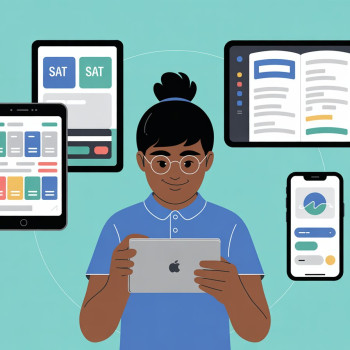Why Adaptive Testing Is the New Normal
If you walked into a test center five years ago and compared the testing room to today, one of the biggest differences might not be the chairs or the devices — it’s the way the test thinks about you. Adaptive testing has moved from research labs and niche exams into mainstream, high-stakes assessments like the Digital SAT. That shift isn’t just technical; it changes the experience, the stakes, and the most effective way to prepare.
At its core, adaptive testing personalizes the second half of a section based on how you performed in the first half. Rather than every student seeing the same sequence of questions, each person receives a tailored second module that better pinpoints their knowledge and skills. The result is a test that’s shorter, more secure, and, in many ways, more accurate.
The fast elevator pitch: why this matters to you
- Shorter test time without losing measurement quality — more efficient timing per question.
- Every question matters, because early performance determines the difficulty mix later on.
- Preparation shifts from rote endurance to strategic practice and accuracy on every item.
How Adaptive Testing Works — Plain English Version
Think of the Digital SAT section like a two-floor apartment. Everyone starts on the first floor where the landlord (the test) watches how you walk, open doors, and answer questions. Based on that performance, the landlord decides whether to invite you upstairs to a room with tougher puzzles or to another room where the puzzles are kinder but still informative. Your final score is based on your work in both rooms.
Technically, each section (Reading & Writing and Math) has two modules. The first module gives a balanced mix of easy, medium, and hard questions. Your performance there determines which second module you get: one with more difficult items if you did well, or one with more accessible items if you struggled. The adaptive design means the test learns about you more quickly and precisely than a one-size-fits-all exam.
Key consequences of the two-module design
- Performance on early questions has outsized influence — getting stuck early can change your path.
- You can’t skip the reality of adaptive scoring: guessing strategically is different from blind guessing.
- The second module isn’t a ‘bonus’ — it’s essential; your section score counts everything together.
Real Advantages for Students — Not Just Technical Buzzwords
Adaptive testing brings genuine student benefits when implemented thoughtfully. Here are the most meaningful ones:
- Precision: The test hones in faster on your strengths and weaknesses, giving colleges a clearer snapshot of your readiness.
- Shorter sittings: Because the adaptive model is efficient, total test time is reduced and there’s more time per question to think deliberately.
- Security and fairness: With many different possible item sequences, tests are harder to leak or game.
- Built-in accommodations flexibility: The digital platform can better support accessibility tools, extended time setups, and other accommodations.
A human perspective
Students often report that when a test is shorter and gives more time per question, anxiety decreases slightly — not because the questions are easier, but because the environment feels less punishing. That emotional shift, while subtle, can improve focus and decision making on test day.
How Adaptive Testing Changes Preparation
Preparation used to be simple: grind through eight full-length tests, simulate the timing, and build stamina. That approach still has value, but adaptive testing adds a new layer. It rewards smart, targeted practice and demands that every early question be taken seriously.
Study strategies that now matter most
- Master the core concepts early. The first module mixes difficulties; showing consistency helps unlock the higher-difficulty module where stronger students can earn more points.
- Prioritize accuracy over speed. With more time per question overall, careful reading and methodical problem solving beat wild guessing.
- Practice on adaptive-format tools. Taking practice tests that mimic the two-module flow helps you internalize pacing and decision thresholds.
- Review adaptive patterns. Learn which question types tend to show up early versus later, and tailor practice to ensure you are strong across the board.
- Use targeted, short sessions for weak areas. Because the test is precise, fixing small gaps can yield disproportionate score gains.
Example: How a 10-minute habit improves your module 1 performance
Say you spend 10 minutes daily practicing data interpretation passages, focusing on extracting information quickly and accurately. Over weeks, you reduce the time you need to understand such passages and increase the accuracy of your first-module answers. That improved consistency in module 1 raises the chance you’ll be routed to the higher-difficulty second module — and that’s where you can demonstrate greater mastery.
Table: What to Practice vs. Why It Helps in an Adaptive Test
| Skill/Practice | What to Do | Why It Helps in Adaptive Testing |
|---|---|---|
| Core content drills | Daily short drills on algebra, grammar fundamentals, and evidence-based reading | Improves consistency in Module 1 so the test routes you to a module that lets you showcase higher-level skills |
| Timed module practice | Two-part practice sessions that mimic Module 1 then Module 2 under test timing | Familiarizes you with pacing and the mental switch between modules |
| Strategic guessing | Learn when to eliminate options and when to make a reasoned guess | Reduces the damage of early uncertainty and preserves score potential |
| Mental stamina routines | Short mindfulness or breathing exercises before practice sections | Stabilizes focus during Module 1 so you don’t lose performance due to anxiety |
Common Concerns Students Have — And Practical Reassurance
Change naturally raises questions. Here are the worries students often share, plus straightforward answers you can use to calm nerves.
“If I do poorly in module 1, am I doomed?”
No. Module 1 contains a mix of difficulty levels by design, and the second module still provides opportunities to earn points. The test’s scoring model uses performance across both modules; an early stumble can be mitigated by solid, focused work afterward. The real risk is giving up mentally — staying engaged gives you the best chance to recover.
“Does adaptive mean harder questions for smart students only?”
Not exactly. The adaptive second module is tailored so students who demonstrate stronger performance face more challenging items, which lets them demonstrate higher-level mastery. But the system is built to compare students fairly; difficulty is not a penalty, it’s an opportunity to show depth.
“How should I approach guessing?”
Make educated guesses. Eliminate obviously wrong choices first, then choose the most defensible option. Because early correct answers can change your path, honing elimination skills boosts your chance of receiving the module that best reflects your readiness.
How Teachers, Counselors, and Tutors Should Adapt
Adaptive testing is a team sport. Teachers and tutors should shift emphasis from raw volume to diagnostic practice and targeted remediation.
What effective coaching looks like now
- Use short adaptive practice blocks followed by immediate feedback and micro-lessons.
- Build diagnostic profiles that identify which question types consistently cause module 1 slips.
- Practice the emotional side: teach quick resets and confidence-building exercises between modules.
Programs like Sparkl’s personalized tutoring can fit naturally into this model by offering 1-on-1 guidance, tailored study plans, and AI-driven insights that help students close specific gaps quickly. When tutors use adaptive-style practice and track progress at the item-type level, students see measurable improvements that matter on test day.
The Role of Technology — Devices, Apps, and Practice Platforms
Digital testing isn’t just about the test questions; it’s about the environment. The Bluebook testing app (or whatever officially provided app your program uses) and approved devices are part of the ecosystem. Practicing on the actual platform or a close simulation removes friction on test day.
What to practice on devices
- Familiarity with navigation: moving between passages, flagging, and reviewing answers within a module.
- Comfort with on-screen tools like highlighting, equation scratch tools, and answer eliminators.
- Device readiness: installing the testing app, practicing under battery and connectivity constraints, and knowing how to borrow or set up a device if needed.
How Colleges and Admissions Interpret Adaptive Scores
One understandable fear is: if everyone’s taking different question mixes, how do colleges compare applicants? The short answer is that psychometricians built the adaptive model to produce scores on the same 400–1600 scale colleges have always relied on. Concordance studies and robust scoring models ensure that a given numeric score reflects comparable achievement regardless of the specific items a student saw.
Admissions teams receive scores that are designed to be fair and interpretable. For students, what matters most is improving the underlying skills that the score represents — critical reading, precise writing, and mathematical reasoning — because those are what admissions offices care about, regardless of format.
Smart Test-Day Tactics for Adaptive Exams
Test-day strategy changes subtly with adaptation in play. Here are practical tactics to make the most of your performance:
- Start strong: Treat the first module like the high-leverage portion of the test — calm, cautious, and accurate beats frantic speed.
- Don’t waste time on perfecting every problem in Module 1. If a question is taking too long, make a reasoned guess and move on. Lingering can cost you multiple items.
- Reset mentally between modules. Use a quick breathing routine or a two-minute checklist to clear frustration or over-excitement.
- Use the tools provided in the app: flag questions, annotate passages, and use built-in calculators or scratch features as needed.
Short pre-module checklist
- Feet flat, posture steady, deep breaths.
- Plan a basic pacing target (e.g., max time per question threshold).
- Remind yourself: module 1 is the opportunity window — stay engaged.
Measuring Progress: What Improvement Looks Like in an Adaptive World
Progress isn’t always linear: a single concept fix can create a disproportionate jump in module routing and overall score. Focus on metrics that matter:
- Consistency rates in early-module question types (accuracy on first-module algebra problems, for example).
- Time-to-decision: how long you take before selecting an answer after reading a question.
- Stress resilience: your ability to recover after a tricky question.
Working with a coach or a personalized platform can help you track these finer-grain indicators. That’s where Sparkl’s expert tutors and AI-driven insights become helpful: they translate practice data into targeted next steps so you don’t waste time on one-size-fits-all drills.
Final Thoughts: Embrace the Change, Master the Strategy
Adaptive testing represents an evolution — not an obstacle. It rewards students who focus on consistent accuracy, cultivate flexible thinking, and engage in targeted practice. The Digital SAT’s adaptive design uses smart measurement to shorten test time and sharpen what it measures. For students, that means shifting study habits from endless test endurance to intelligent, diagnostic practice.
If you’re preparing now, your plan can be simple and powerful: practice on device-like platforms, prioritize early-module consistency, build tactical guessing and pacing skills, and consider one-on-one guidance when you need to move the needle quickly. Personalized tutoring — whether through dedicated coaches or services like Sparkl that combine human expertise with AI-driven insights — can accelerate progress by zeroing in on the precise question types that determine module routing.
Change can feel uncertain, but it also opens opportunity. Adaptive testing gives you a clearer picture of where you shine and where a focused hour of practice will return the biggest reward. Treat every first-module question as a moment to show your best work, and you’ll be surprised how quickly the adaptive system begins to work in your favor.
Quick checklist to get started this week
- Install and practice on the official or closely simulated testing app for at least two full adaptive modules.
- Pick three weak item types and do focused 10–15 minute drills on them for five days.
- Practice one breathing or reset routine to use between modules.
- Consider scheduling one diagnostic tutoring session to build a targeted study plan — a single expert session can clarify the most efficient next steps.
Adaptive testing is not a mystery; it’s a more thoughtful measurement. Get curious, practice smart, and let the system help reveal the truest version of your skills.














No Comments
Leave a comment Cancel